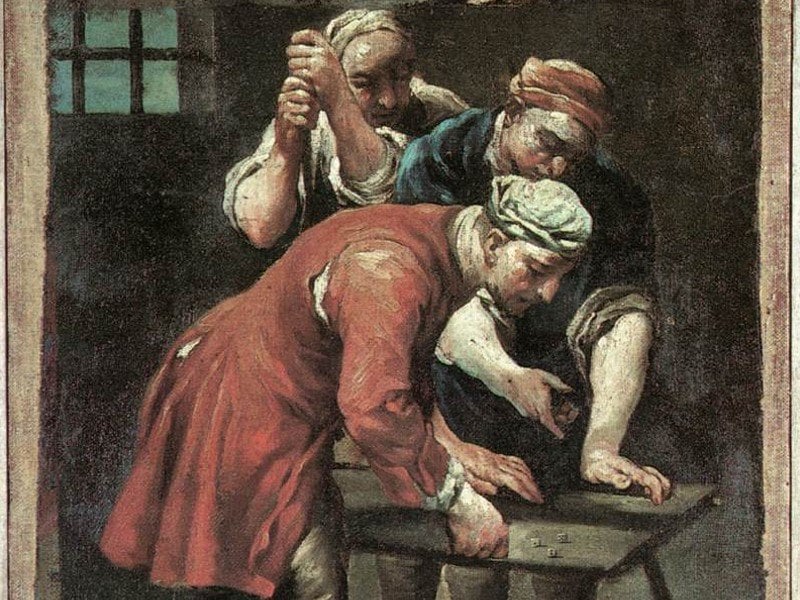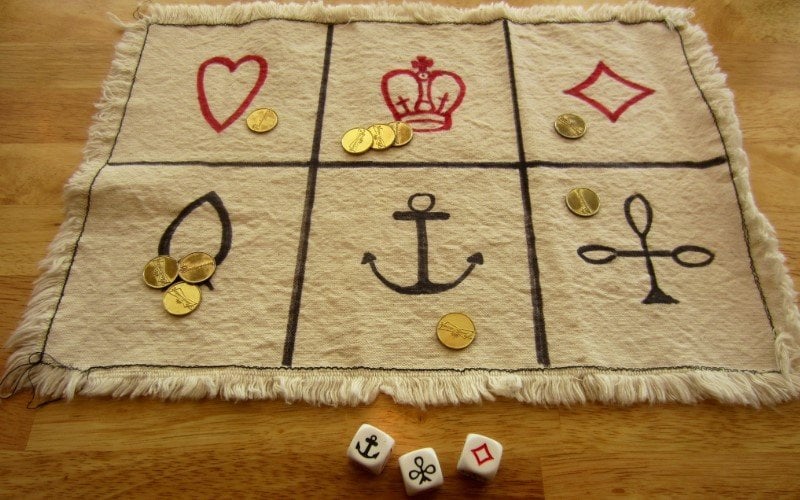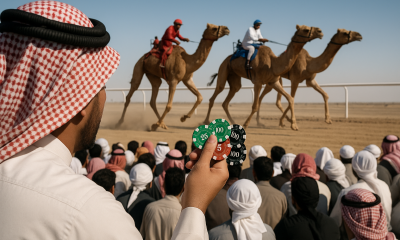around the world
The Popularity of Crown and Anchor in the Caribbean

Originally a game played on boats by sailors, Crown and Anchor is now a niche cultural game that is popular in the Caribbean. The game, which doesn’t need much more than three custom 6-faced dice and a designated throwing area, feels almost improvisational in structure. It doesn’t have many convoluted rules or special conditions. Crown and Anchor revolves around pure chance, and guessing which sides of the dice will land faced up.
Gambling is very much a part of the game, and what attracts people to Crown and Anchor. And this dice throwing venture spread to all corners of the British Empire, from Australia to the Caribbean. It carved itself into the culture in the latter, with many Caribbean islands still hosting games of Crown and Anchor today. As a gambling game, it is quite strictly regulated, but the charm and excitement around this game is still very much felt today.
How Crown and Anchor Came to Be
Crown and Anchor was popularised by the Royal Navy as a means for sailors to socialise and gamble. It is quite similar to Chuck A Luck, a game that was quite big in English pubs. Chuck A Luck was popular among the working classes, and also went by the names Sweat Cloth, Chucker Luck and Chuck Luck. This culture of gambling in English pubs worked its way into the Royal Navy, where card games like poker or bridge, and dice throwing gambles such as Chuck A Luck became casual entertainment.
The game was adapted to have a maritime taste and theme. Instead of using 6-faced dice with numbers from 1 to 6, Crown and Anchor used custom symbols on their 6-faced dice. The dice would have a Crown, Anchor, Heart, Spade, Club and Diamond. The last four images being the same as the playing cards. Instantly, the game had a more nautical appeal. And as it didn’t require much else than a mat and a few gaming dice, it was very easy to transport.

Spreading to Islands Around the World
Crown and Anchor spread far and wide, reaching as far as New Zealand and Australia, where the gambling game was welcomed with open arms. Australia also had its fair share of gambling ventures, from throwing pennies in Two Up to betting on horse races. Another very popular British pastime. Crown and Anchor also spread to the New World, across the Americas and the Caribbean. In North America, Chuck A Luck caught on more prominently. It was given names such as Bridcage or Sweat and Sweat Rag. Due to its naval military connotations, Crown and Anchor didn’t catch on so much in North America.
However, it was quite big in the Caribbean islands, where nautical themed games were more than welcome. Crown and Anchor is still very much a part of the gambling tradition in Bermuda, Jamaica, and other Caribbean islands. It is also prominent in the Channel Islands, off the coast of France.
How to Play Crown and Anchor
You can learn to play this game in minutes, one of the many reasons why Crown and Anchor is such a big hit. The game uses three dice that have the symbols: Crown, Anchor, Spade, Diamond, Club and Hearts. There is a playing mat where the dice are thrown, and a designated betting zone where you can place your wagers. In other dice games, like craps, there are lots of different bets based on the total number or outcome of the throw. Or Sic Bo, where you have numerous wagering possibilities with a payout hierarchy based on the riskiness of the bet, Crown and Anchor is dead simple.
You basically place a prop bet on one of the symbols, and then you hope that 1, 2 or all three dice will land with that symbol face up. The payout depends on how many dice match your bet, and if none do, you lose your wager.
Bets, Payouts and House Edge
Despite its simplicity and seemingly straightforward gameplay, Crown and Anchor has a pretty high house edge. Landing 1 winning symbol from any of the three dice doesn’t seem to be much of a gamble. But the likelihood of winning doesn’t match the implied probability from the payout.
- One Match – 1:1
Two Matches – 2:1
Three Matches – 3:1
The chance of you losing are around 57.8%; hitting 1 match are 34.72%; two matches are 6.94%; and getting all three matching symbols are 0.46%. If you were to line up the bets and calculate the EV and probability of landing, you would find varying house edges.

One Match
There is a 34.72% chance of winning, and the bet pays out at 1:1. The Implied Probability is 50%, thus making a 15.28% house edge.
Two Matches
The chances of winning are just 6.94% and two matches pays out 2:1. IP is 33.33%, making a 26.39% house edge.
Three Matches
Three matches only have a 0.46% chance of actually happening, and the bet pays out 3:1. The IP is 25%, making a 24.54% house edge.
Dice Games Played in Casinos
Crown and Anchor is not found a lot in casinos, landbased or their digital counterparts. The gambling culture hasn’t really taken on in casinos like other dice throwing games. It could be because of the high house edge, which would turn off gambling strategists looking for a low house edge.
Or it could be a result of the association to the British Commonwealth. Another aspect that may play against Crown and Anchor is that it doesn’t have many types of bets. This is a game with just 1 type of bet and no prominent side bets.
At casinos you are far more likely to encounter Craps or Sic Bo. Craps is a historic dice game that is huge in Europe, and has spread all over the world. The variety of bets, complex turn-based play and huge diversity of possible outcomes gives craps a sophisticated edge. You can also build craps strategies, working out different ways to challenge the risks and try to win.
Sic Bo is more similar to Crown and Anchor, in that it uses 3 dice. But these are numbered dice. And there are plenty of bets that players can make, from the total sum of the numbers thrown to different combinations of dice faces. Dabbling with different wagers and combining payouts in different wagers makes Sic Bo a pretty good one for working strategies around.

Casino Game Alternatives to Crown and Anchor
In its essence, Crown and Anchor is a game of chance in which you make your bet, and then sit back and watch what happens. You don’t have any influence over what happens in the round. Not like poker or blackjack, where you have to make decisions that can shape the outcome.
So in that regard, there are many similar types of casino games to Crown and Anchor. For instance, roulette is also a betting game that uses pure chance. You aren’t betting on the result of a dice, but instead on where the ball will fall on a 37 (or 38) segmented wheel.
Another game that revolves around chance and randomness is slot machines. There are games that have loads of additional elements to complicate the gameplay, but at the heart of slots gaming, everything is determined by chance. Or, we should say, Random Number Generators, that create impossibly long sequences of random outcomes.
Slots can have bonus rounds, special symbols, or alternative mechanics in the way the game pays. Of the latter, we mean cascading reels, cluster pays, ways pays, and expanding symbols, among many more. These all enhance the user experience when playing slots, and make the games more player-centric and interactive.
You can find plenty of slots that have nautical themes, similar to the symbols and imagery used in Crown and Anchor. There are plenty of Pirate, Nature, and Deep Sea Treasure themed games that provide similar maritime or oceanic vibes.
Where to Play Crown and Anchor
What was once a highly riveting game played by merchants and sailors has now become very obscure and niche. There are several mobile gaming apps and sites where you can play Crown and Anchor. But playing it for real money, which is arguably the game’s big appeal, is quite rare.
It is strictly regulated in the Caribbean islands, though you can find Crown and Anchor offered at some legitimate venues. Of course, there are probably a few taverns and inns where you can play friendly wagers and test the game out. Or, you can buy a set for yourself as a souvenir. But never forget that games like Crown and Anchor have a definite addictive quality about them.
When you play similar dice games or other gambling ventures, be sure to play responsibly. Don’t look at it as a means to make money. These are games for entertainment purposes; winning and losing are all part of the experience. So only play with money you can afford to lose, never chase your losses, and play for the fun of it.














